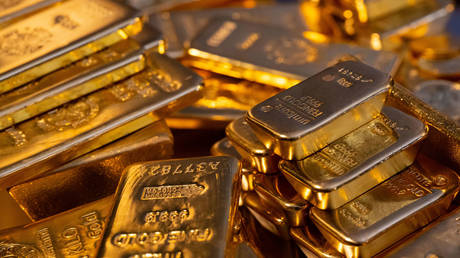
In a year marked by surging commodity prices and heightened global demand for precious metals, Swedish industrial giant Sandvik AB has shattered records, propelled by a relentless gold rally that’s fueling mining activity worldwide. The company’s shares hit an all-time high following stellar third-quarter results, underscoring how the energy-intensive mining sector is thriving amid economic uncertainties and shifting reserve strategies. But this story extends far beyond one company—central banks are hoarding gold at unprecedented rates, raising questions about global financial stability and investment opportunities.
Sandvik’s Surge: Mining Boom Drives OrdersSandvik, a key player in mining equipment and services, reported a 16% organic increase in overall orders for the third quarter, far exceeding analyst expectations of 11% growth. The mining segment alone saw a 24% jump in orders, driven primarily by elevated gold and copper prices that have encouraged miners to ramp up production and invest in new gear.
Favorable commodity levels, robust demand for minerals, and easing interest rates have created a perfect storm for high mining activity, boosting demand for Sandvik’s tools, machinery, and services.
This performance highlights the interconnectedness of energy and mining industries. Extracting gold requires significant energy inputs, from powering heavy machinery to processing ore, making companies like Sandvik indirect beneficiaries of the broader energy transition and commodity supercycle. As gold prices continue their upward trajectory—hitting multiple all-time highs in 2025—the rally shows no signs of slowing, with implications rippling through global supply chains.

Global Gold Purchases: Top 10 Countries Leading the Charge
Central banks have been net buyers of gold throughout 2025, adding to reserves amid volatile markets. According to the latest data from the World Gold Council, net purchases rebounded to 19 tonnes in August alone, following a brief pause in July.
Year-to-date figures through August reveal a clear pattern of accumulation, particularly among emerging market economies.
Here’s a breakdown of the top 10 countries by net gold purchases in 2025 (year-to-date, based on reported data in tonnes):
|
Rank
|
Country
|
Net Purchases (tonnes)
|
Notes
|
|---|---|---|---|
|
1
|
Poland
|
67
|
Largest buyer; raised gold share target in reserves to 30%.
|
|
2
|
China
|
~36+ (reported to July; ongoing streak)
|
Tenth consecutive month of increases; actual may be higher due to reporting lags.
gold.org
|
|
3
|
Kazakhstan
|
32
|
Steady accumulator; added 7 tonnes in August alone.
gold.org
|
|
4
|
Turkey
|
21
|
Consistent buying for 26+ months; includes Treasury holdings.
|
|
5
|
Ghana
|
5
|
Incremental additions amid African mining boom.
|
|
6
|
Czech Republic
|
~2+ (incremental)
|
30-month buying streak; targeting 100 tonnes by 2028.
|
|
7
|
Azerbaijan
|
Not quantified (significant)
|
Ranked among top buyers early in the year.
gold.org
|
|
8
|
Indonesia
|
~1+ (incremental)
|
Small but steady; total holdings at 80 tonnes.
|
|
9
|
Bulgaria
|
~1+ (incremental)
|
Modest increases reported.
|
|
10
|
El Salvador
|
<0.5 (September addition)
|
Positioning for long-term reserve balance.
|
Global net purchases are on track to surpass the record 1,045 tonnes from 2024, driven by these key players.
Why Are Countries Buying Large Amounts of Gold?
In 2025, the U.S. dollar depreciated by 12%, amplifying gold’s appeal as it appreciates in dollar terms.Key reasons include:
- Economic Uncertainty and Inflation Hedge: With global inflation lingering and interest rates fluctuating, gold provides stability and protects against currency devaluation.
- Geopolitical Tensions and Trade Disputes: Escalating conflicts, including trade tariffs implemented in April 2025 by the U.S., have heightened risks. Countries like China and Russia are reducing reliance on the dollar to mitigate sanctions or fiscal disruptions.
- Portfolio Diversification: Central banks are shifting from U.S. Treasuries (e.g., Japan and China have trimmed holdings) toward gold for better risk mitigation over decades. Gold’s liquidity and durability make it a reliable store of value.
- De-Dollarization Efforts: Nations are promoting alternatives like the yuan (now 3.2% of global reserves) while bolstering gold to support currency internationalization and guard against U.S. debt concerns ($28.9 trillion as of September 2025).
- Safe-Haven Demand Amid Instability: Regional issues in the Middle East and Latin America have prompted increased allocations, viewing gold as a politically neutral asset.
These factors explain why even at record-high prices, central banks remain committed—95% of surveyed institutions expect global gold reserves to rise further.
What Should Investors Look For?
- Gold Price Trends and Breakouts: Monitor spot prices, which have smashed records in 2025 due to central bank demand and geopolitical risks. Look for support levels around $2,500/oz and resistance near $3,000/oz.
- Mining Stocks and Equipment Providers: Companies like Sandvik benefit directly from increased orders. Track earnings reports from miners (e.g., Newmont, Barrick) and suppliers for signs of sustained demand.
- ETFs and Financial Instruments: Gold ETFs like GLD or IAU offer easy exposure without physical storage. Consider leveraged options if you’re bullish, but beware volatility.
- Central Bank Announcements: Follow World Gold Council reports and IMF data for purchase updates—spikes from China or Poland could drive prices higher.
- Geopolitical and Economic Indicators: Watch U.S. Treasury yields, dollar strength, inflation data, and trade news. Escalating tensions could accelerate buying.
- Physical Gold vs. Paper: For long-term holds, physical bars or coins provide tangibility, but factor in storage costs. Avoid overpaying premiums during rallies.
In summary, Sandvik’s record-breaking performance is a microcosm of a larger gold rush, fueled by central banks’ strategic hoarding. As energy demands in mining intersect with global reserve shifts, investors who stay informed on these dynamics stand to benefit. The rally rumbles on—will you ride the wave?






